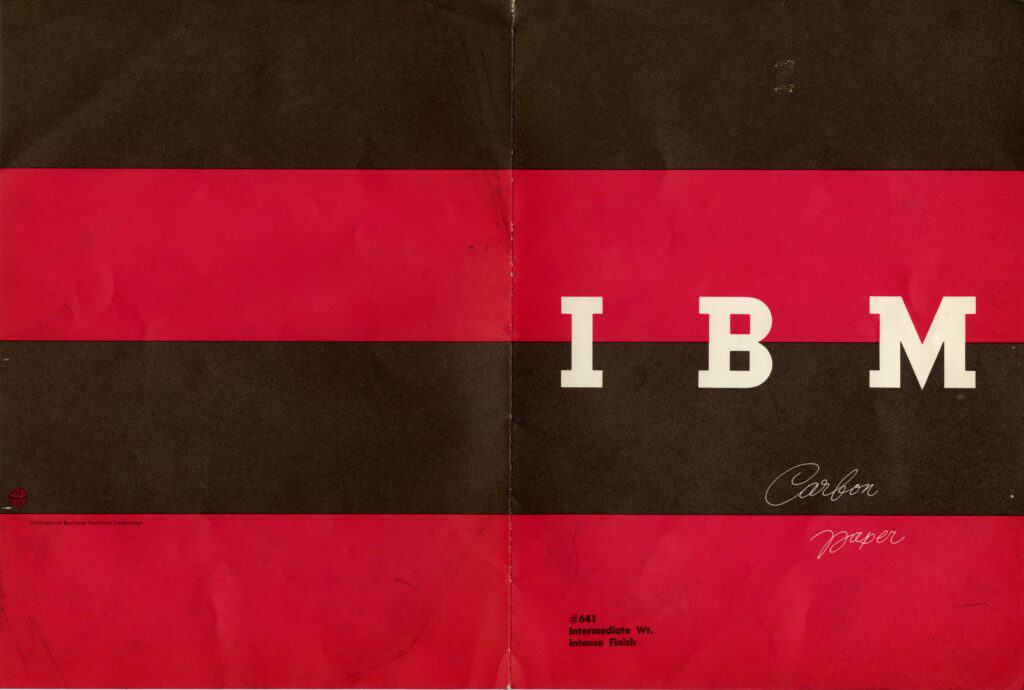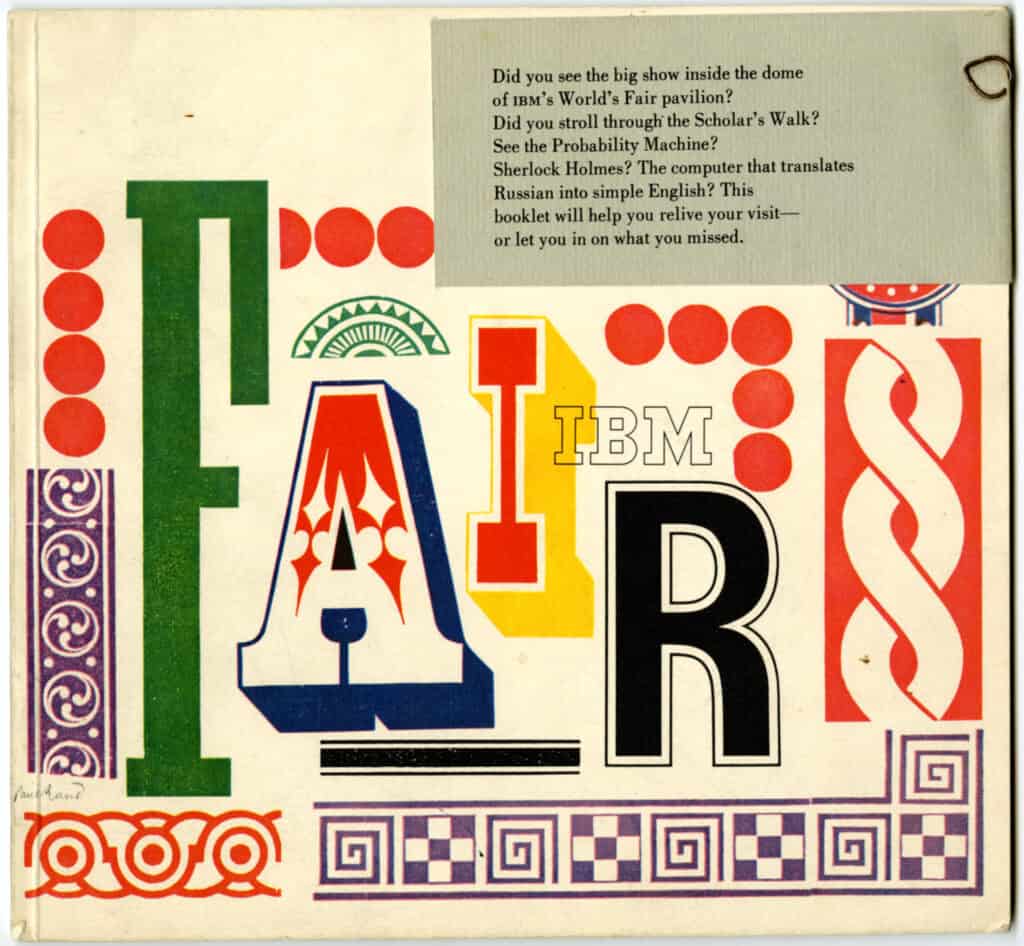
Until the arrival of Eliot Noyes as IBM consulting director of design, IBM’s many office products were a confusion of styles: from 1930s-era punched card equipment—complete with steel Queen Anne legs—to room sized computers inflected with mid-century styling, festooned with tiny signal lamps. As IBM consolidated its various product lines in the early 1960s, most importantly with the 1964 System/360 mainframe, it also consolidated its corporate style: Noyes simplified IBM’s design vernacular to represent clean typography, a minimalist aesthetic, unified branding and office equipment and computers that were intuitive and easy to use.
Along with the corporate overhaul by Noyes and his associates, husband and wife team Charles and Ray Eames also worked closely with IBM to re-imagine the company for the 20th century. While Eliot Noyes was an industrial designer who focused on corporate design and branding, the Eameses were renowned for their contributions to furniture design, architecture, and multimedia productions.
Both the Eameses and Noyes shared a commitment to modernist design principles, including functionality, simplicity, and human-centered design. They believed in creating designs that were not only aesthetically pleasing but also practical and user-friendly.
The Office of Charles and Ray Eames is among the most important firms in the history of design. Their 40-year career spanned architecture, furniture, exhibition design, film, graphics, books, toys, art and more.
Charles Eames was initially thrust into prominence by architect/designer/curator Eliot Noyes in 1940 when Charles and fellow Cranbrook Academy of Art faculty member Eero Saarinen won the 1940 MoMA Competition for Organic Design in Home Furnishings using the molded plywood manufacturing processes that the Eameses later perfected. It is for this furniture and the processes invented to manufacture it that the Eameses are perhaps most famous.
Although The Eameses designed some of the most successful furniture pieces of all time for Herman Miller and continued to innovate in this area throughout their career, their aperture opened significantly in the early 1950s. At this time, Charles and Ray began to explore communications theory and the power of film and multimedia exhibitions to transmit ideas, concepts and emotions.
A Communications Primer
During the time The Eames Office was cultivating their interest in communications, data processing and computing were still essentially new phenomena; largely the domain of governments and large corporations. Indeed, the implications of this technology were only beginning to enter popular culture. IBM was the dominant force in early computing in America, a subject that was at best misunderstood, if not somewhat feared by the general public.

1960s Vari-Vue “3D” Lenticular Postcard featuring the IBM 1440.
There was a clear opportunity for IBM to shape public opinion around computing technology in 1956 when newly installed CEO Thomas Watson Jr. hired Eliot Noyes to develop the company’s first corporatewide design initiative. It is impossible to overstate the impact of this comprehensive design program on modern corporate branding practice. Indeed, it is the benchmark by which all others might be judged.

Industrial Design Magazine, 1957.
In March 1957, Industrial Design Magazine noted: “Not long ago, in February, 1956, architect and industrial designer Eliot Noyes was asked by IBM to become Consultant Director of Design, and since his appointment he has led the company into an ambitious and unusual program to coordinate and upgrade design across the board, across every aspect of the company's vast operations. This extends from the IBM trademark, through packaging, graphics, exhibitions, interiors and interior furnishings, such as the new Paul Rand drapery, to the business machines themselves and the buildings of the company.”

IBM Carbon Paper Packaging, 1950s, Paul Rand.
Noyes, in turn, hired a cadre of design luminaries including Paul Rand, George Nelson, Edgar Kaufmann, Eero Saarinen and The Eames Office to help not only remake IBM’s image, but to root the technology juggernaut in the fertile soil of Design and influence America’s perception of the societal value of computing technology.
The Eames Office, at the request of Eliot Noyes, produced an animated film for IBM, The Information Machine: Creative Man and the Data Processor, shown at the Noyes-designed IBM pavilion at the 1958 Brussels World Fair. This, and many subsequent works, appear prophetic as we tumble headlong into a new AI computing paradigm.
The Information Machine, 1958, The Eames Office.
Over the next 20 years, The Eames Office created dozens of exhibitions, films, books and experiences for IBM, most of which positioned computers as a natural extension of human reasoning and a tool with unparalleled potential to improve our world.
Some of this work, like the IBM pavilion for the 1964 NY World’s Fair, was seen by millions of people. Yet, surprisingly, much of the work produced under this partnership remains largely obscure.
Which is precisely why collecting it was so much fun!
IBM at the Fair, 1965, The Eames Office.
The collection consists of several hundred artifacts from the 1950s–1970s, all of which the author acquired in the first decade of the new millenium. Originally exhibited at the LUNAR offices in Palo Alto in Spring 2011, much of the collection is now archived at the Computer History Museum. It includes ephemera from small and large-scale exhibitions, including Mathematica: A World of Numbers...and Beyond and the landmark IBM pavilion at the 1964-1965 New York World’s Fair in Flushing Meadows.

Exhibition invitation designed by Laura Martini and the author, punched at the Computer History Museum, 2011.
In the collection are all manner of Eames Office, Paul Rand and IBM staff designed ephemera including original brochures and annual reports, press kits and photographs, slides and postcards, packaging, magazine articles, and even a Cartier-produced trophy from the 1964/5 New York World’s Fair.

IBM Fair Brochure, 1964, Paul Rand.
Charles and Ray Eames pioneered a deeply human approach to design which, although evident in all of their work, was particularly powerful in their IBM projects. Their clear communication of technology's role in society, through myriad IBM-sponsored exhibitions, short films and books, became the reference for a new form of corporate design and citizenship. Their work presents a finely integrated model that is as relevant today as it was 70 years ago.
These artifacts trace the massive impact the IBM design program had on American public perception of mathematics, science and computing technology. Critical examination and documentation of this largely overlooked partnership between Eliot Noyes, Paul Rand, George Nelson, Eero Saarinen, Edgar Kaufmann and The Eames Office is a vehicle for remembering not only the historical precedents that link design and technology, but also a potent case study detailing how the human centered design process can be used to fundamentally shift attitudes and the human experience.